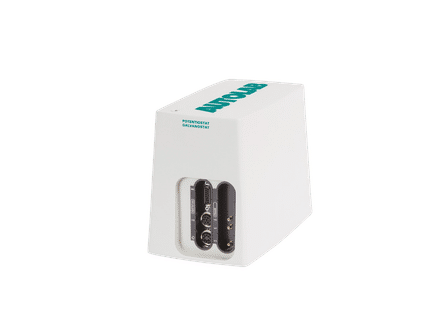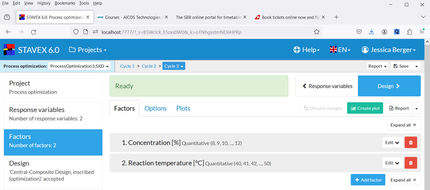Dynamic light scattering (also known as Photon Correlation Spectroscopy) is a powerful technique in physics, which can be used to determine the size distribution profile of small particles in solution.
Description
When light hits small particles the light scatters in all directions (Rayleigh scattering) so long as the particles are small compared to the wavelength (< 250 nm). If the light source is a laser, and thus is monochromatic and coherent, then one observes a time-dependent fluctuation in the scattering intensity. These fluctuations are due to the fact that the small molecules in solutions are undergoing Brownian motion and so the distance between the scatterers in the solution is constantly changing with time. This scattered light then undergoes either constructive or destructive interference by the surrounding particles and within this intensity fluctuation information is contained about the time scale of movement of the scatterers.
There are several ways to derive dynamic information about particles’ movement in solution by Brownian motion. One of such methods is dynamic light scattering, also known as quasi elastic laser light scattering. The dynamic information of the particles is derived from an autocorrelation of the intensity trace recorded during the experiment. The second order autocorrelation curve is generated from the intensity trace as follows:
-

where  is the autocorrelation function at a particular wave vector, is the autocorrelation function at a particular wave vector,  and delay time, and delay time,  and and  is the intensity. At short time delays the correlation is high because the particles do not have a chance to move to a great extent from the initial state that they were in. The two signals are thus essentially unchanged when compared after only a very short time interval. As the time delays become longer, the correlation starts to exponentially fall off to zero, meaning that there is no correlation between the intensity of scattering of the initial state with the final state after a long time period has elapsed (relative to the motion of the particles). This exponential decay is obviously then related to the motion of the particles specifically, the diffusion coefficient. To fit the decay (i.e. the autocorrelation function), numerical methods are used based on calculations of assumed distributions. If the sample was monodisperse the decay would simply be a single exponential. The Siegert equation, relates the second order autocorrelation curve with the first order autocorrelation is the intensity. At short time delays the correlation is high because the particles do not have a chance to move to a great extent from the initial state that they were in. The two signals are thus essentially unchanged when compared after only a very short time interval. As the time delays become longer, the correlation starts to exponentially fall off to zero, meaning that there is no correlation between the intensity of scattering of the initial state with the final state after a long time period has elapsed (relative to the motion of the particles). This exponential decay is obviously then related to the motion of the particles specifically, the diffusion coefficient. To fit the decay (i.e. the autocorrelation function), numerical methods are used based on calculations of assumed distributions. If the sample was monodisperse the decay would simply be a single exponential. The Siegert equation, relates the second order autocorrelation curve with the first order autocorrelation  function as follows: function as follows:
-
![g^2(q;\tau)= \ 1+\beta\left[g^1(q;\tau)\right]^2](images/math/e/2/9/e29fb022c2fbf44a2663948948708d94.png)
where  is a parameter which is a correction factor depending on the geometry and alignment of the laser beam of the light scattering setup; it is roughly equal to the inverse of the number of speckle (see Speckle pattern) from which light is collected. Once the autocorrelation curve has been generated, different mathematical approaches can be employed to fit the curve and thus determine the z-averaged translational diffusion coefficient. The simplest approach is to treat the first order autocorrelation function as the sum of single exponential decays with fractions is a parameter which is a correction factor depending on the geometry and alignment of the laser beam of the light scattering setup; it is roughly equal to the inverse of the number of speckle (see Speckle pattern) from which light is collected. Once the autocorrelation curve has been generated, different mathematical approaches can be employed to fit the curve and thus determine the z-averaged translational diffusion coefficient. The simplest approach is to treat the first order autocorrelation function as the sum of single exponential decays with fractions  where where  is the decay rate. is the decay rate.
-

Data analysis
Cumulant method
One of the most common methods is the cumulant method [1] [2], from which in addition to the sum of the exponentials above, more information can be derived about the variance of the system as follows:
-

where  is the average decay rate and is the average decay rate and  is the second order polydispersity index (or an indication of the variance). A third order polydispersity index may also be derived but this is only necessary if the particles of the system are highly polydisperse. The z-averaged translational diffusion coefficient is the second order polydispersity index (or an indication of the variance). A third order polydispersity index may also be derived but this is only necessary if the particles of the system are highly polydisperse. The z-averaged translational diffusion coefficient  may be derived at a single angle or at a range of angles depending on the wave vector may be derived at a single angle or at a range of angles depending on the wave vector  . .
-

with
-

where  is the incident laser wavelength, is the incident laser wavelength,  is the refractive index of the sample and is the refractive index of the sample and  is angle at which the detector is located with respect to the sample cell. is angle at which the detector is located with respect to the sample cell.
Depending on the anisotropy and polydispersity of the system, a resulting plot of  vs. vs.  may or may not show an angular dependence. Spherical particles will show no angular dependence, hence no anisotropy. A plot of may or may not show an angular dependence. Spherical particles will show no angular dependence, hence no anisotropy. A plot of  vs. vs.  will result in a horizontal line. Particles with a shape other than a sphere will show anisotropy and thus an angular dependence when plotting of will result in a horizontal line. Particles with a shape other than a sphere will show anisotropy and thus an angular dependence when plotting of  vs. vs.  .[3] The intercept will be in any case the .[3] The intercept will be in any case the  . The . The  can be calculated into the hydrodynamic radius for a sphere through the Stokes-Einstein equation. can be calculated into the hydrodynamic radius for a sphere through the Stokes-Einstein equation.
One must note that the cumulant method is valid for small  and sufficiently narrow and sufficiently narrow  .[4] One should seldom use parameters beyond .[4] One should seldom use parameters beyond  , because overfitting data with many parameters in a power-series expansion will render all the parameters including , because overfitting data with many parameters in a power-series expansion will render all the parameters including  and and  , less precise [5]. , less precise [5].
CONTIN algorithm
An alternative method for analyzing the autocorrelation function can be achieved through an inverse Laplace transform known as CONTIN developed by Steven Provencher.[6].[7] The CONTIN analysis is ideal for heterodisperse, polydisperse and multimodal systems which cannot be resolved with the cumulant method. The resolution for separating two different particle populations is approximately a factor of five or higher and the difference in relative intensities between two different populations should be less than 1 : 1E-5.
Maximum entropy method
The Maximum entropy method is an analysis method that has great developmental potential. The method is also used for the quantification of sedimentation velocity data from analytical ultracentrifugation. The maximum entropy method involves a number of iterative steps to minimize the deviation of the fitted data from the experimental data and subsequently reducing the  of the fitted data. of the fitted data.
See also
References
- ^ *Koppel, D. E. Analysis of Macromolecular Polydispersity in Intensity Correlation Spectroscopy: The Method of Cumulants. (1972), J. Chem. Phys., 57, 4814-4820.
- ^ *Frisken, B. J. Revisiting the methods of cumulants for analysis of dynamic light scattering data. (2001), Appl. Opt., 40, 4087-4091.
- ^ *Gohy, J.-F., Varshney, S. K., Jérôme, R. Water-soluble complexes formed by poly(2-vinylpyridinium)-block-poly(ethylene oxide) and poly(sodium methacrylate)-block-poly(ethylene oxide) copolymers. (2001), Macromolecules, 34, 3361-3366.
- ^ *Hassan, P. A., Kulshreshtha, S. K. Modification to the cumulant analysis of polydispersity in quasielastic light scattering data. (2006) J. Colloid Interface Sci., 300, 744-748.
- ^ *Chu, B. Laser Light scattering: Basic Principles and Practice, 2nd Edition. Academic Press (1992)
- ^ *Provencher, S. W. CONTIN: A GENERAL PURPOSE CONSTRAINED REGULARIZATION PROGRAM FOR INVERTING NOISY LINEAR ALGEBRAIC AND INTEGRAL EQUATIONS. (1982), Comp. Phys. Commun., 27, 229-242.
- ^ *Provencher, S. W. CONSTRAINED REGULARIZATION METHOD FOR INVERTING DATA REPRESENTED BY LINEAR ALGEBRAIC OR INTEGRAL EQUATIONS. (1982), Comp. Phys. Commun., 27, 213-227.
|






 is the autocorrelation function at a particular wave vector,
is the autocorrelation function at a particular wave vector,  and delay time,
and delay time,  and
and  is the intensity. At short time delays the correlation is high because the particles do not have a chance to move to a great extent from the initial state that they were in. The two signals are thus essentially unchanged when compared after only a very short time interval. As the time delays become longer, the correlation starts to exponentially fall off to zero, meaning that there is no correlation between the intensity of scattering of the initial state with the final state after a long time period has elapsed (relative to the motion of the particles). This exponential decay is obviously then related to the motion of the particles specifically, the diffusion coefficient. To fit the decay (i.e. the autocorrelation function), numerical methods are used based on calculations of assumed distributions. If the sample was monodisperse the decay would simply be a single exponential. The Siegert equation, relates the second order autocorrelation curve with the first order autocorrelation
is the intensity. At short time delays the correlation is high because the particles do not have a chance to move to a great extent from the initial state that they were in. The two signals are thus essentially unchanged when compared after only a very short time interval. As the time delays become longer, the correlation starts to exponentially fall off to zero, meaning that there is no correlation between the intensity of scattering of the initial state with the final state after a long time period has elapsed (relative to the motion of the particles). This exponential decay is obviously then related to the motion of the particles specifically, the diffusion coefficient. To fit the decay (i.e. the autocorrelation function), numerical methods are used based on calculations of assumed distributions. If the sample was monodisperse the decay would simply be a single exponential. The Siegert equation, relates the second order autocorrelation curve with the first order autocorrelation  function as follows:
function as follows:
![g^2(q;\tau)= \ 1+\beta\left[g^1(q;\tau)\right]^2](images/math/e/2/9/e29fb022c2fbf44a2663948948708d94.png)
 is a parameter which is a correction factor depending on the geometry and alignment of the laser beam of the light scattering setup; it is roughly equal to the inverse of the number of speckle (see Speckle pattern) from which light is collected. Once the autocorrelation curve has been generated, different mathematical approaches can be employed to fit the curve and thus determine the z-averaged translational diffusion coefficient. The simplest approach is to treat the first order autocorrelation function as the sum of single exponential decays with fractions
is a parameter which is a correction factor depending on the geometry and alignment of the laser beam of the light scattering setup; it is roughly equal to the inverse of the number of speckle (see Speckle pattern) from which light is collected. Once the autocorrelation curve has been generated, different mathematical approaches can be employed to fit the curve and thus determine the z-averaged translational diffusion coefficient. The simplest approach is to treat the first order autocorrelation function as the sum of single exponential decays with fractions  where
where  is the decay rate.
is the decay rate.


 is the average decay rate and
is the average decay rate and  is the second order polydispersity index (or an indication of the variance). A third order
is the second order polydispersity index (or an indication of the variance). A third order  may be derived at a single angle or at a range of angles depending on the wave vector
may be derived at a single angle or at a range of angles depending on the wave vector 

 is the incident laser wavelength,
is the incident laser wavelength,  is the refractive index of the sample and
is the refractive index of the sample and  is angle at which the detector is located with respect to the sample cell.
is angle at which the detector is located with respect to the sample cell.
 vs.
vs.  may or may not show an angular dependence. Spherical particles will show no angular dependence, hence no anisotropy. A plot of
may or may not show an angular dependence. Spherical particles will show no angular dependence, hence no anisotropy. A plot of  , because overfitting data with many parameters in a power-series expansion will render all the parameters including
, because overfitting data with many parameters in a power-series expansion will render all the parameters including  and
and  , less precise
, less precise  of the fitted data.
of the fitted data.


